- Scraping:
- Heat Guns & Radiant Heat Machines:
- Chemical Paint Removers:
- Burning:
- Pressure Washing:
- Sandblasting:
Scraping paint works well when paint is already flaking off the surface, as shown in Figure 6.
This is a common occurrence on window frames and siding, because moisture gets between the finish and the surface of the material. It is also a common occurrence when primers or undercoats are not applied or when they are applied incorrectly.
Additional information on primers and undercoats
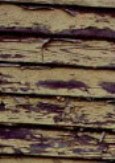
Figure 6 - Paint flaking off wood siding

Figure 7 - Paint scraper
Paint scrapers, as shown in Figure 7, are available in numerous shapes and sizes, some with integral blades while others have replaceable blades. Consideration should be given to what style and/or shape will best suit the specific project.
Heat guns, as shown in Figure 8, and radiant heat machines, as shown in Figure 9, soften the finish making it very easy to remove with a scraper.
When working with heat it is important to keep the heat generating tool moving so that the wood or base material is not charred or burned. It is best to use a heat gun or radiant heat machine that operates below 1,100°F.
The negative of heat guns or radiant heat machines is that as the soften the paint the paint will be giving off gases that in many cases are volatile and/or toxic. It is best to wear a quality HEPA respirator, as shown in Figure 10, when using either one of these tools, as well as eye protection.
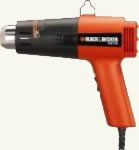
Figure 8 - Heat gun
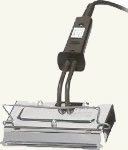
Figure 9 - Radian heat paint remover
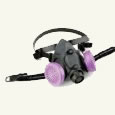
Figure 10 - HEPA Respirator
Chemical paint removers are one option for removing paint. Chemical paint removers or strippers as they are often called are available in two basic forms; a liquid and a paste.
The liquid paint removers are generally designed to remove one or two layers of finish at most. They are a good choice of product if you desire to remove a varnish or urethane layer so that you can add a new top finish to a stained or painted item. Liquid paint removers are available in brush on and spray on application methods.
The paste paint strippers are designed to remove multiple layers of finish. The products are brushed on, left to sit awhile and then are either scraped off or in some cases the paint stripper has an emulsifier within the chemical make-up allowing it to be washed off with a hose, taking the paint and the stripper off the surface. Because the product is in a paste form it will adhere to most surfaces including ceilings and walls without running or dripping.
It is impossible to give specific details on the use of paint strippers as they all have their own variations to methods and techniques. It is important to read and follow the manufacturer's instructions as to use explicitly. It is also critical to understand and follow all the safety procedures and precautions that the manufacture of the paint stripper or remover stipulates.
Note: Many manufacturer's are touting "environmentally friendly" paint strippers and removers. The addition of a lemon scent does not make a chemical any less hazardous, not does it make it safe for the environment. Read the label carefully before purchasing "environmentally friendly" paint strippers and removers.
A second chemical stripping method is known as dipping. In this case the item is taken to a company that does paint stripping and they dip it in a number of baths of paint strippers and cleaners.
While this dipping method generally removes all the unwanted paint and finishes, it can also be detrimental to glue joints as in many cases the solvents that will remove paint and finish will also soften and dissolve glues and adhesives.

Figure 11 - Torch flame spreader

Figure 12 - Pressure washer

Figure 13 - Sandblaster
Using an open flame from a torch is not as common as it used to be, but is still utilized on the exterior of homes. Using a standard propane nozzle with a flame spreading attachment, as shown in Figure 11, the flame is used to burn off the paint. The biggest negative is that house fires have started and individuals have been badly burned using this method.
With so many other techniques available, I do not recommend the use of an open flame to burn off paint.
The use of a pressure washer, as shown in Figure 12, to remove paint is common for large outdoor projects such as siding, decks, masonry and concrete. Although one must be prepared to get wet, a pressure washer is an easy tool to use, is not overly dangerous and can make quick work of even a large project.
In some cases chemicals are added to the water in order to aid in the paint removal, although for the homeowner, just the use of the pressure washer should be adequate to remove most paint and other finishes. The pressure washer also has the advantage that it removes grime, dirt and molds as it is removing the paint from outdoor surfaces.
Sandblasting works extremely well on outdoor metal work, such as stair and patio railings, metal furniture and if necessary masonry walls, concrete patios and driveways. In many cases the only alternative is the use of a grinder. Sandblasting is the technique of blowing an abrasive at high speed at an object. It may be noted that where originally the abrasive used was sand, it is now more common to use other materials such as walnut shells and glass beads.
The use of blasting requires special safety equipment such as hoods (Figure 14) and gloves (Figure 15) and it should not be undertaken by individuals who have no experience with using a machine of this nature.
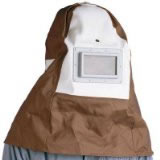
Figure 14 - Sandblaster's hood
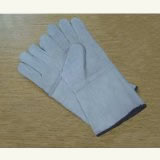
Figure 15 - Sandblaster's gloves
The biggest negative about any blasting equipment is the clean-up. In many cases it can take longer to clean-up the site than it did to remove the paint or finish. Because sand or abrasive blasting will easily remove the paint, it will also do damage to soft materials such as wood, vinyl and light aluminum siding as it removes the paint. Recently special abrasive materials have been produced to remove paint from softer materials such as vinyl and plastic.
